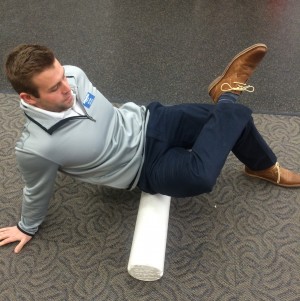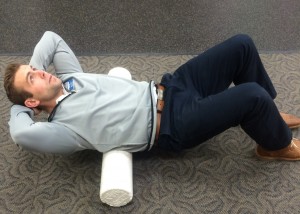
Benefits of Foam Rolling for Hockey Warm-Up
1 CommentAs a medical professional who not only works with the Chicago Blackhawks but also a large number of hockey players of all levels, one of the more recurrent questions I receive is, “how to adequately warm-up before taking the ice?” My answer is the foam roll, for a variety of reasons.
“Kneading” the muscles and myofascia (connective tissue that intertwines throughout the body) prepares the body for playing hockey. Place your body weight on a foam roll to massage out the trigger points (also referred to as muscle knots). If you are new to foam rolling, start by foam rolling the quads, hamstrings, groins, piriformis/gluteals, lateral thigh/ITB and lower back for about 1 minute per muscle group (see attached pictures). Slowly roll throughout the whole length of the muscle area, and then focus on the tender spots.


Working the trigger points allows for improved blood flow to the muscle tissue. Foam roll exercise readies the muscles to perform quickly, especially with hard contractions that occur in the sport of hockey. The skating stride is a unique, athletic movement that cannot be 100 percent replicated on dry land. For example, at the end of a stride the groin muscle is greatly elongated and rotated. It then quickly contracts and pulls the leg back to the midline of the body from that lengthened/stretched position. Imagine this repeated hundreds of times throughout a practice or game. It’s easy to see how the groin muscles can get worn down and injured.
Often times I refer to the analogy that our muscles have properties similar to a rubber band. Mike Boyle, a strength and conditioning professional who worked with the Boston Bruins, Boston Redsox,  Boston University hockey and USA Women’s Olympic Team, first explained this to me. If you take a rubber band, tie a knot in the center of it, and pull on the ends, the knot gets tighter and the band on each side of the knot gets thinner and weaker. The more you stretch the rubber band and use the contractile (or stretchy) properties of the band, the tighter the knot gets. However, if you eliminate the knot by untying it, the length improves along with the contraction abilities of the rubber band, and in our case, the muscle.
Boston University hockey and USA Women’s Olympic Team, first explained this to me. If you take a rubber band, tie a knot in the center of it, and pull on the ends, the knot gets tighter and the band on each side of the knot gets thinner and weaker. The more you stretch the rubber band and use the contractile (or stretchy) properties of the band, the tighter the knot gets. However, if you eliminate the knot by untying it, the length improves along with the contraction abilities of the rubber band, and in our case, the muscle.
The Blackhawks have greater than 10 sizes and types of foam rolls in the United Center weight-room that are used daily. In the past 5 years, foam rolling truly has become a normal routine for hockey players to both warm-up and recover for the physical demands of the sport.
Below are a few benefits to adding foam rolling in to your warm-up before taking the ice:
- Helps deep tissue and muscle mobilization throughout the legs, hips and back after just 5-10 minutes
- Foam rolling addresses muscle imbalances, increases range of motion, increases long-term flexibility, and can help a muscle recover after exercise and aid in recovery.
- Foam rolls are small and portable. You can take them with you just about anywhere *The short rolls fit in a hockey bag without taking up too much room.
- You only need a small space for rolling out different parts of the body (key for ice arena locker rooms and hallways, which can be cramped).

1 Comment
Jeff Blindauer
Great article Patrick! I saw a kid post it on Twitter. If I were to take one thing from this, it’s that some of our kids don’t foam roll long enough.
Great expertise! I’m saving this and posting it.
Regards,
Jeff Blindauer – Director Fury Performance Training